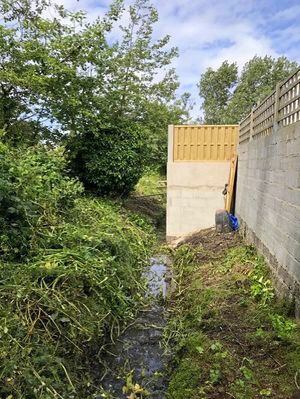Parishes look into how wall came to be built in douit
QUESTIONS are being asked about how a wall came to be built in a douit on the Vale/St Sampson’s border.

The Development & Planning Authority refused a retrospective planning application, but has since said that no enforcement action would be taken.
The wall is at the back of a property, Rocha, at Braye Clos, La Route du Braye, Vale, which backs onto the Saltpans Housing Target Area.
According to the officer’s report on the retrospective planning application: ‘It would appear that sometime between 1996 and 2004 Rocha built up to, and is likely to have encroached into, the douit.’
The constables of the Vale and St Sampson’s, Richard Leale and Paul Le Pelley respectively, and the owners of the Saltpans HTA, all said the wall had been extended into the douit since the current owners moved there in 2018.
Mr Leale said the matter was being looked in to and he did not wish to comment further. Mr Le Pelley said it was being followed up and they hoped to arrange a meeting with the DPA.
The property owner, Suce Rocha, said that while the wall had been rebuilt, it went no further than previously.
‘The wall was falling down so my husband dug down and built it up again,’ she said. ‘It goes no further now than it did before.’
Deputy Chris Le Tissier, who lives in the Vale, and who is a DPA board member, said the parish constables had asked him to look at the matter.
‘I will bring it up at the next board meeting,’ he said. ‘I’ll be gathering information as part of my constituency role before I report back.’
Retrospective planning permission was refused because the replacement wall, fencing and gate to the rear of the property was inappropriately sited and had encroached into the douit.
A DPA spokesman said the rear boundary wall was rebuilt by the homeowner without first seeking planning permission. The homeowner later submitted an application retrospectively and subsequently received notification of refusal following representations.
‘However, following this notification further investigation has shown that the circumstances surrounding this development are tantamount to similar circumstances which would be exempt from needing planning permission,’ he said.
‘In addition, the applicant has since provided photographic evidence which indicates that the wall was rebuilt in the same position as the previously existing wall. Due to these further investigations and evidence it has been decided that no enforcement action will be taken.’
Guernsey Water did not wish to comment on the matter and would not say whether it was investigating.
In consultation to the retrospective planning application, it said that no part of the wall/fence or its foundations should be built in the stream or on its banks and there should be no restriction on the width of the stream.
On its website, Guernsey Water reminds property owners of their legal obligation to clear streams and douits of any growth or obstructions to ensure the free flow of water. All debris must also be removed from pipes and culverts.





